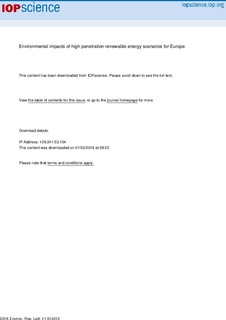| dc.contributor.author | Berrill, Peter | |
| dc.contributor.author | Arvesen, Anders | |
| dc.contributor.author | Scholz, Yvonne | |
| dc.contributor.author | Gils, Hans Christian | |
| dc.contributor.author | Hertwich, Edgar G. | |
| dc.date.accessioned | 2017-11-08T14:35:08Z | |
| dc.date.available | 2017-11-08T14:35:08Z | |
| dc.date.created | 2016-03-30T12:19:19Z | |
| dc.date.issued | 2016 | |
| dc.identifier.issn | 1748-9326 | |
| dc.identifier.uri | http://hdl.handle.net/11250/2465014 | |
| dc.description.abstract | The prospect of irreversible environmental alterations and an increasingly volatile climate pressurises societies to reduce greenhouse gas emissions, thereby mitigating climate change impacts. As global electricity demand continues to grow, particularly if considering a future with increased electrification of heat and transport sectors, the imperative to decarbonise our electricity supply becomes more urgent. This letter implements outputs of a detailed power system optimisation model into a prospective life cycle analysis framework in order to present a life cycle analysis of 44 electricity scenarios for Europe in 2050, including analyses of systems based largely on low-carbon fossil energy options(natural gas, and coal with carbon capture and storage (CCS)) as well as systems with high shares of variable renewable energy (VRE) (wind and solar). VRE curtailments and impacts caused by extra energy storage and transmission capabilities necessary in systems based on VRE are taken into account. The results show that systems based largely on VRE perform much better regarding climate change and other impact categories than the investigated systems based on fossil fuels. The climate change impacts from Europe for the year 2050 in a scenario using primarily natural gas are 1400 Tg CO2-eq while in a scenario using mostly coal with CCS the impacts are 480 Tg CO2-eq. Systems based on renewables with an even mix of wind and solar capacity generate impacts of 120–140 Tg CO2-eq. Impacts arising as a result of wind and solar variability do not significantly compromise the climate benefits of utilising these energy resources. VRE systems require more infrastructure leading to much larger mineral resource depletion impacts than fossil fuel systems, and greater land occupation impacts than systems based on natural gas. Emissions and resource requirements from wind power are smaller than from solar power. | nb_NO |
| dc.language.iso | eng | nb_NO |
| dc.publisher | IOP Publishing | nb_NO |
| dc.rights | Navngivelse 4.0 Internasjonal | * |
| dc.rights.uri | http://creativecommons.org/licenses/by/4.0/deed.no | * |
| dc.title | Environmental impacts of high penetration renewable energy scenarios for Europe | nb_NO |
| dc.type | Journal article | nb_NO |
| dc.type | Peer reviewed | nb_NO |
| dc.description.version | publishedVersion | nb_NO |
| dc.source.volume | 11:014012 | nb_NO |
| dc.source.journal | Environmental Research Letters | nb_NO |
| dc.identifier.doi | 10.1088/1748-9326/11/1/014012 | |
| dc.identifier.cristin | 1347579 | |
| dc.relation.project | Norges forskningsråd: 209697 | nb_NO |
| dc.description.localcode | © 2016 IOP Publishing Ltd. Original content from this work may be used under the terms of the Creative Commons Attribution 3.0 licence. Any further distribution of this work must maintain attribution to the author(s) and the title of the work, journal citation and DOI. | nb_NO |
| cristin.unitcode | 194,64,25,0 | |
| cristin.unitname | Institutt for energi- og prosessteknikk | |
| cristin.ispublished | true | |
| cristin.fulltext | original | |
| cristin.qualitycode | 1 | |

